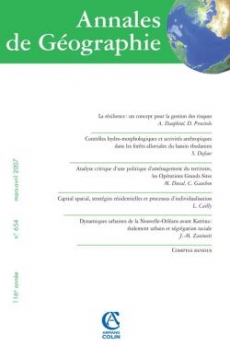
Annales de Géographie n° 654 (2/2007)
Pour acheter ce numéro, contactez-nous
Recevez les numéros de l'année en cours et accédez à l'intégralité des articles en ligne.
L’analyse et la gestion des milieux naturels se fondent sur une connaissance approfondie des processus qui structurent les espaces étudiés. La description de ceux-ci constitue une première étape indispensable à la conceptualisation des thématiques de recherches et à la mise en oeuvre des pratiques d’aménagement. En nous appuyant sur l’exemple de forêts alluviales dans le bassin du Rhône, nous illustrons ici la nécessité de développer également une démarche quantitative qui prenne en considération les dynamiques naturelles, les activités anthropiques et leurs interactions à différentes échelles spatiales. Ces exemples portent sur la dynamique contemporaine des corridors fluviaux, la structure des communautés végétales alluviales et la croissance ligneuse. D’autre part, les implications en matière de gestion sont présentées, notamment en discutant la validité des concepts sur lesquels se fondent les gestionnaires (diversité, naturalité, fonctionnalité…). Nous discutons, enfin, les distinctions existant entre les notions d’état de référence et d’état passé et nous proposons de substituer celle de dynamique de référence à celle d’état de référence.
Floodplain forests present a complex and diverse mosaic of vegetation units that result from a combination of physical and temporal gradients, biotic interactions, and human pressures. Qualitatively, the links between vegetation and hydromorphological processes have been explored by several authors, but some aspects remain poorly documented. This paper seeks to illustrate why a quantitative approach is needed to describe the impact of hydro-morphological channel evolution on water and sediment flux, and thus on floodplain forests. At the landscape scale, human control is fundamental to both the evolution of geomorphic surfaces and the structural characteristics of the riparian corridor. In here, abandonment of forestry and pastoral practices can lead to an increase in floodplain vegetation cover (Ain River) and, conversely, human activities can reduce forest cover, leading to its fragmentation (Arve River). With lateral channel mobility, the diversity of the landscape mosaic increases, even if the structural diversity also increases by human activities. At the community and individual scale, results show that channel adjustment due to upstream controls can change floodplain ecological conditions and therefore forest structure and evolution. It also shows that vegetation dynamics are controlled by multiple processes acting at varying temporal and spatial scales. Considering the importance of interactions and variability within fluvial corridors, what guidance can be given to managers ? This framework proposes sustainable development but is still inefficient in integrating riparian values. Some progress must be made in terms of integrative management and socio-economic understanding of services provided by floodplain forests. The results obtained within this framework make it possible to discuss the validity of concepts used in floodplain forest management : diversity, naturalness and functionality. Functionality appears to be the best insurance to preserve ecological and socio-economic values of alluvial woodlands. Finally, we propose to substitute, for management purposes, the classic “reference state” with a “reference dynamic” concept.